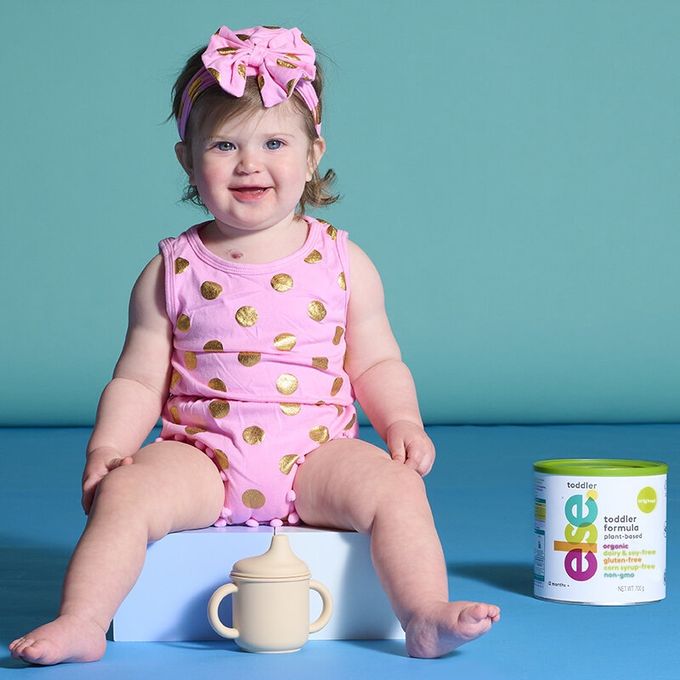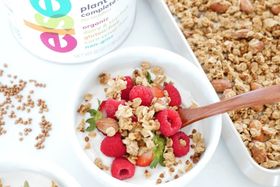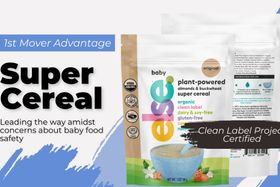Decoding Hydrolysed Formula: Advantages for Baby & Toddler Nutrition
Updated May 17, 2024

If you’re asking whether a hydrolysed formula could benefit your infant, especially those with sensitive stomachs or allergy concerns, you’ve come to the right place. This advanced type of infant formula is designed for easier digestion and may prevent allergic reactions to cow’s milk proteins. Throughout this article, we will guide you through the science behind hydrolysed formulas, their types, and when they’re the preferred choice for your baby’s dietary needs.
Key Takeaways
Hydrolysed formulas are specialized infant formulas that facilitate easier digestion and are designed for babies with varying levels of cow’s milk protein sensitivity, with extensively hydrolysed options being suitable for about 90% of infants with cow’s milk allergies.
These formulas provide multiple benefits including easier digestion due to smaller protein sizes, potential in allergy prevention by reducing protein allergenicity, and supporting infants’ immune systems with added nutrients.
Hydrolysed formulas differ from standard cow’s milk formulas in nutritional content, suitability for specific infant needs (e.g., gastrointestinal issues), and cost; they’re often more expensive and more available in high-income countries.
Understanding Hydrolysed Formulas
A standout in the realm of infant nutrition, hydrolysed formulas are specialized infant formulas made from cow’s milk proteins, including partially hydrolyzed whey protein, that have been broken down into smaller proteins, thus facilitating easier digestion for infants. These formulas are available in two main types: partially hydrolysed and extensively hydrolysed, each catering to different degrees of cow’s milk protein sensitivities in infants.
The extensively hydrolyzed formula is ideal for infants with higher sensitivities, but what does this entail? Let’s break it down.
Partially Hydrolysed Formula
Partially hydrolysed formulas are designed with cow’s milk proteins that are broken into smaller pieces. The proteins in these formulas are broken down to be smaller in size, closely resembling the size of human milk proteins, and thus, making it easier to digest. Infants with functional gastrointestinal issues may particularly benefit from these formulas as they have been shown to reduce regurgitation and improve stool frequency.
However, partially hydrolyzed formulas are not recommended for infants with confirmed milk allergies because the proteins in a partially hydrolyzed formula, which contain partially hydrolyzed protein, can still elicit severe allergic reactions.
Extensively Hydrolysed Formula
On the other hand, extensively hydrolysed formulas feature proteins that are broken down into very small fragments, making them significantly less likely to be recognized by the infant’s immune system. These formulas are considered hypoallergenic because the protein fragments are small enough to avoid triggering an immune response, which is critical for infants with allergies, such as IgE mediated food allergies and milk allergy. Clinical studies have shown that extensively hydrolysed formulas are suitable for about 90% of infants with cow’s milk allergy.
Furthermore, these formulas may also have a role in reducing early signs of diabetes development. A notable benefit of some hydrolysed formulas is that they can aid in building a tolerance to cow’s milk, with the potential for infants to return to regular milk consumption within as little as 6 months.
Benefits of Hydrolysed Formulas for Infants
Hydrolysed formulas are more than just a substitute for standard formulas; they come with a host of benefits that cater to infants’ specific nutritional needs. From easier digestion to allergy prevention and immune system support, these formulas provide comprehensive nutritional solutions for infants. The benefits of hydrolysed formulas include:
Easier digestion for infants, as the proteins are broken down into smaller chains, comparable to the size of breast milk proteins
Allergy prevention, as the proteins are hydrolysed to reduce the risk of allergic reactions
Immune system support, as these formulas often contain added nutrients to support the immune system
These benefits make hydrolysed formulas a great option for infants with specific nutritional needs.
Moreover, one of the standout benefits of hydrolysed formulas is their role in the prevention of cow’s milk protein allergy and other food allergies in infants. These formulas also contribute to supporting the developing immune system of infants, thus creating a robust foundation for their health.
Easier Digestion
Easier digestion is one of the hallmarks of hydrolysed formulas. The proteins in these formulas are broken down into smaller peptides and strands, which are easier for infants to digest. This reduced protein size in hydrolysed formulas can alleviate common digestive discomforts such as gas, fussiness, and crying, by requiring less effort for digestion and absorption.
Furthermore, for preterm infants, protein hydrolysate formulas are known to accelerate gastric emptying and intestinal transit, offering additional digestive benefits.
Allergy Prevention
Preventing allergies is another significant advantage of hydrolysed formulas. They are designed for babies with cow’s milk protein allergy, as the proteins are broken down to a degree that they are unlikely to trigger an allergic response. Hydrolysed formulas are designed with reduced protein allergenicity to diminish the risk of cow’s milk allergy in infants. Extensively hydrolyzed formulas are effective in managing cow’s milk protein allergies in most infants by providing very small protein parts to minimize allergic reactions.
Clinical evidence shows that certain hydrolysed formulas can reduce the incidence of atopic dermatitis in high-risk infants compared to those fed standard cow’s milk formula. However, there is ongoing debate about the effectiveness of hydrolysed formulas; while some evidence shows they can be beneficial for allergy-prone infants, there is no consensus that they prevent allergies or autoimmune diseases compared with exclusive breastfeeding.
Immune System Support
In addition to digestion and allergy prevention, hydrolysed formulas also play a critical role in supporting infants’ developing immune systems. These formulas are designed to provide infant nutrition similar to breast milk while reducing allergen exposure.
This can potentially benefit the developing immune system of infants, a crucial factor in preventing infections and promoting long-term health.
Comparing Hydrolysed Formulas to Standard Formulas
While hydrolysed formulas bring several benefits to the table, it is essential to understand how they differ from standard formulas. These differences span across various aspects, including nutritional content, suitability for different infant needs, and cost and availability.
Standard cow’s milk-based formulas contain full-size cow’s milk proteins, which are larger than breast milk proteins and require more digestive work to absorb. Let’s delve deeper into these differences in cow’s milk.
Nutritional Content
When it comes to nutritional content, hydrolysed formulas may differ from standard formulas. Due to the process of protein hydrolysis, hydrolysed formulas may have differing protein contents compared to standard cow’s milk formulas. Furthermore, there are variations in carbohydrate, lipid, and micronutrient content and types between hydrolysed formulas and standard formulas, which may affect the nutritional profile.
Suitability for Different Infant Needs
Hydrolysed formulas cater to specific infant needs, proving advantageous for infants experiencing gastrointestinal issues, reflux, or colicky crying when consuming standard formulas. For instance, partially hydrolysed formulas with high whey content are recommended for babies with reflux.
For infants who are intolerant to milk, hydrolysed formulas can alleviate the gastrointestinal symptoms associated with the intake of intact milk proteins.
Cost and Availability
Protein hydrolysate formulas are generally more expensive than standard cow’s milk formulas. This higher cost has raised concerns about whether the benefits of these formulas are adequately supported by high-quality evidence.
In terms of availability, hydrolysed formulas have seen an increase, particularly in high-income countries, since the late 1990s.
Choosing the Right Formula for Your Baby
Choosing the right formula for your baby is no small task. It involves consulting a healthcare professional, testing multiple options through trial and error, and closely monitoring the baby’s response. The ingredients in a formula, particularly the proteins and carbohydrates, are much more important than the brand when selecting the right one for an infant.
It’s not just about addressing health needs but also about considering the baby’s taste preferences and willingness to take certain formulas.
Consulting a Healthcare Professional
Before selecting specialized formulas for infants with allergies or other conditions, it is essential to seek guidance from a pediatrician or a dietitian. Medical experts in pediatrics, nutrition science, and gastroenterology contribute to the development and recommendation of certain infant formulas, focusing on scientific principles and nutritional adequacy.
Moreover, consultation with a healthcare professional is advised before trying lactose-free formulas, as instances of lactose intolerance in infants are very rare.
Trial and Error
Finding the right formula often involves testing multiple options and considering the baby’s specific nutritional and health needs. Parents may need to test multiple formulas, which can include different types of hydrolysed formulas, before finding the optimal one.
The specific nutritional and health needs of the baby, such as allergy management or digestion support, play a significant role in selecting a formula.
Monitoring Baby's Response
It’s crucial to monitor the baby’s tolerance and response to new formulas, including stool quality and regularity. If symptoms are observed in the infant or toddler after consuming certain foods, including new formulas, medical consultation is recommended to achieve an accurate diagnosis.
In the case of infants with milk protein sensitivities, a transition from regular to hydrolyzed formula is necessary, though it is safe to mix both types during the transition period.
» Discover the key signs that formula isn't suitable for your baby
Hydrolysed Formulas and Breastfeeding
While breastfeeding is essential for at least the first four months for providing infants with the necessary nutrients for growth and normal development, hydrolysed formulas can supplement breastfeeding, particularly for infants who may not be fully meeting their nutritional needs through breast milk alone.
Complementary Feeding
Complementary feeding with hydrolysed formulas can be beneficial for infants who may not be fully meeting their nutritional needs through breastfeeding alone. Hydrolysed formulas provide a nutritional alternative for breastfed infants who are at risk of allergies or cannot tolerate certain proteins found in regular breast milk.
Infants who show signs of cow’s milk allergy, specifically cow’s milk protein allergy, can benefit from the substitution of their regular breastfeeding diet with an extensively hydrolysed formula. For infants experiencing difficulties in digesting breast milk proteins, hydrolysed formulas can serve as a digestive-friendly option. Clinical studies have demonstrated that hydrolysed formulas can successfully complement breastfeeding, leading to improved health outcomes, such as reduced incidence of atopic dermatitis in susceptible infants.
Transitioning from Breast Milk
Transitioning from breast milk to hydrolysed formulas should be guided by health professionals and tailored to the infant’s specific needs. Partially hydrolysed formulas are considered a suitable alternative for infants transitioning from breast milk who cannot be exclusively breastfed.
Else Toddler Nutrition Drink to Help Transition Off Breastmilk & Infant Formula
As an alternative to hydrolysed formula, Else Toddler Nutrition Drink is made using a gentle process and providing complete protein from buckwheat and almonds, designed to supplement the diet of toddlers aged 1-3 years. Please check with your HCP to check suitability for your toddler's needs.
Else™ Toddler Omega contains complete protein from buckwheat and almonds, diverse fat profile from almond butter, coconut oil, and rapeseed oil. It’s designed to supplement the diet of toddlers ages 1-3 years. Else™ Toddler Omega should be used as the sole source of nutrition only under medical supervision.
Supporting Lactating Parents
Lactating parents should seek dietary counseling to ensure their diet provides essential nutrients while excluding allergens that affect their infant.
The protein in Else™ Toddler Omega is derived from buckwheat and almonds, with the addition of amino acids.
Summary
This concluding section will encapsulate the key points from the article, reaffirming the benefits of hydrolysed formulas and their role in infant nutrition. It will underline how these formulas provide a comprehensive nutritional solution, from easier digestion to allergy prevention and immune system support. The section will also emphasize the importance of consulting a healthcare professional in choosing the right formula, monitoring the baby’s response, and the role of hydrolysed formulas in complementing breastfeeding.
Frequently Asked Questions
Is hydrolyzed protein good for babies?
Hydrolyzed protein can be beneficial for babies, particularly for those who struggle with digesting full-size proteins or have digestive issues. It can help manage colic due to cow's milk allergy and may provide relief within 48 hours.
What is the difference between hydrolyzed and amino acid formulas?
Amino acid formulas are hypoallergenic and made up of free amino acids, while hydrolyzed formulas contain fragments of milk protein that may trigger allergic reactions in some individuals. Therefore, amino acid formulas are milk-free and non-allergenic.
Is Nutramigen a hydrolyzed formula?
Yes, Nutramigen is a hydrolyzed formula designed to help manage cow's milk allergy in infants.
Is gentlease a hydrolyzed formula?
Yes, Gentlease is a partially hydrolyzed formula, designed to be easy to digest and help with common feeding issues in infants.
When to use hydrolysed formula?
Hydrolyzed formula should be used in infants with cow's milk allergy or inexplicable digestion issues. It is a hypoallergenic option with proteins broken down into small particles to reduce the risk of allergic reactions.
The content and advice provided in this article is for informational purposes only and is not a substitute for medical diagnosis, treatment, advice for specific medical conditions. Always consult a pediatrician to understand the individual needs of your child. The article expresses the views of the brand editor.










